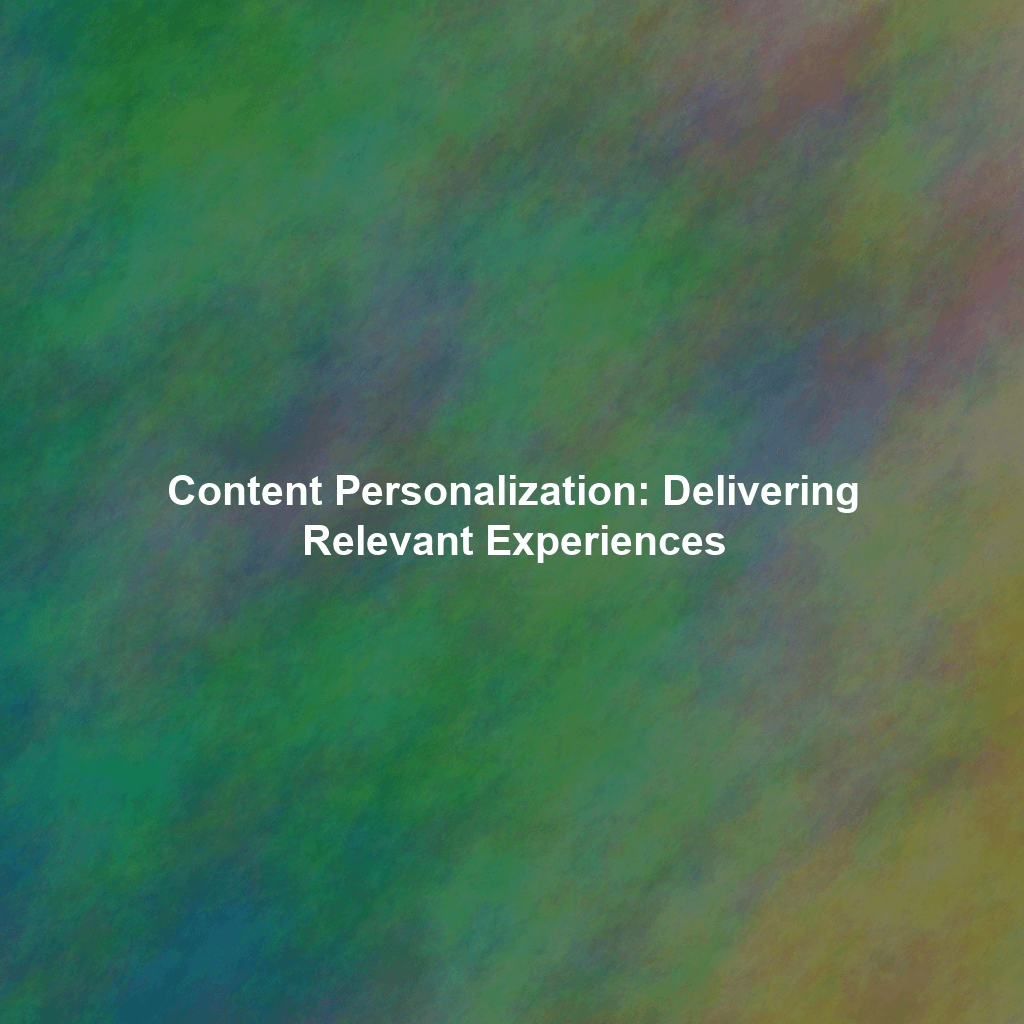Introduction: Beyond Generic Content – The Power of Personalization
Why Content Personalization Matters: The Benefits Unveiled
The shift towards content personalization is driven by a multitude of benefits that impact both the customer and the business. Here are some key advantages:
Increased Engagement and Attention
Relevant content grabs attention and keeps users engaged. When content speaks directly to their needs and interests, they are more likely to spend time consuming it, exploring your website, and interacting with your brand.
Improved Customer Experience
Personalization demonstrates that you understand and value your audience. By providing tailored experiences, you create a positive impression and foster a stronger sense of connection with your brand. This translates into improved customer satisfaction and loyalty.
Higher Conversion Rates
When content is relevant, it naturally drives higher conversion rates. Whether you’re aiming to generate leads, drive sales, or encourage sign-ups, personalized content is more likely to motivate users to take action.
Enhanced Brand Loyalty
Customers appreciate brands that understand their needs and cater to their preferences. Personalization builds trust and strengthens relationships, leading to increased brand loyalty and repeat business.
Better ROI on Content Marketing
By delivering more relevant and effective content, you maximize the impact of your content marketing efforts. This translates into a better return on investment (ROI) for your content marketing budget.
Deeper Customer Insights
The data you collect through personalization efforts provides valuable insights into your audience’s behavior, preferences, and needs. This information can be used to further refine your content strategy and improve your overall marketing effectiveness.
Key Strategies for Effective Content Personalization
Implementing content personalization requires a strategic approach and a deep understanding of your audience. Here are some key strategies to consider:
Audience Segmentation: Knowing Your Customers
Segmentation is the foundation of any successful personalization strategy. Divide your audience into distinct groups based on demographics, psychographics, purchase history, behavior, and other relevant factors. This allows you to create targeted content that resonates with each segment.
Data Collection and Analysis: The Fuel for Personalization
Gathering and analyzing data is crucial for understanding your audience and personalizing their experiences. Utilize various data sources, such as website analytics, CRM data, social media insights, and customer surveys, to gain a comprehensive view of your customers.
Dynamic Content: Adapting to Individual Needs
Dynamic content adapts to the individual user based on their profile and behavior. This can include personalized headlines, images, calls to action, and even entire sections of content. Implement dynamic content on your website, in emails, and across your marketing channels.
Personalized Recommendations: Guiding the User Journey
Offer personalized recommendations based on a user’s past behavior, browsing history, and preferences. This can include product recommendations, content suggestions, and other relevant offers.
Triggered Content: Delivering the Right Message at the Right Time
Triggered content is delivered based on specific actions or events. For example, you might send a welcome email to new subscribers, a thank-you email after a purchase, or a reminder email to users who abandoned their shopping cart.
Location-Based Personalization: Connecting on a Local Level
Tailor content based on the user’s geographic location. This can include localized offers, events, and information that is relevant to their area.
Behavioral Targeting: Responding to User Actions
Adjust content based on how a user interacts with your website or app. For example, if a user frequently visits a specific section of your website, you can show them more content related to that topic.
Examples of Content Personalization in Action
To illustrate the power of content personalization, here are some real-world examples:
Personalized Email Marketing
Sending targeted emails based on subscriber demographics, purchase history, and browsing behavior. This can include personalized product recommendations, special offers, and relevant content updates.
Dynamic Website Content
Displaying different content on your website based on the user’s location, industry, or interests. This can include personalized headlines, images, and calls to action.
Personalized Product Recommendations
Recommending products to users based on their past purchases, browsing history, and other relevant factors. This is commonly seen on e-commerce websites.
Personalized Learning Paths
Creating customized learning paths for students based on their skill level and learning goals. This is common in online education platforms.
Personalized Onboarding Experiences
Tailoring the onboarding experience for new users based on their role, industry, or goals. This helps users quickly understand the value of your product or service.
Personalized Social Media Ads
Showing targeted ads on social media platforms based on user demographics, interests, and behavior. This can include ads for products, services, or content.
Overcoming the Challenges of Content Personalization
While content personalization offers significant benefits, it’s important to be aware of the potential challenges involved:
Data Privacy Concerns
Collecting and using personal data requires careful consideration of privacy regulations and ethical considerations. Be transparent about how you collect and use data, and provide users with control over their information.
Data Accuracy and Reliability
Ensure that your data is accurate and reliable. Inaccurate or outdated data can lead to irrelevant or even offensive personalization.
Complexity and Implementation
Implementing content personalization can be complex, requiring the right technology, expertise, and resources. Start small and gradually scale your efforts as you gain experience.
Over-Personalization and Creepiness
Avoid over-personalization that feels intrusive or creepy. Strive for a balance between personalization and privacy.
Maintaining Consistency
Ensure that your personalized experiences are consistent across all channels and devices. A fragmented experience can be confusing and frustrating for users.
Tools and Technologies for Content Personalization
A variety of tools and technologies can help you implement content personalization effectively. These include:
Customer Relationship Management (CRM) Systems
CRMs store customer data and provide insights into their behavior and preferences. They are essential for segmenting your audience and personalizing your interactions.
Marketing Automation Platforms
Marketing automation platforms automate marketing tasks and enable you to deliver personalized content based on triggers and workflows.
Website Personalization Platforms
These platforms allow you to personalize the content on your website based on user behavior, demographics, and other factors.
Data Management Platforms (DMPs)
DMPs collect and manage data from various sources, providing a comprehensive view of your audience.
Content Management Systems (CMS)
Some CMS platforms offer built-in personalization features or integrations with personalization tools.
Analytics Platforms
Analytics platforms track user behavior and provide insights into the effectiveness of your personalization efforts.
Conclusion: Embracing the Future of Content Marketing
Content personalization is no longer a luxury; it’s a necessity for success in today’s competitive landscape. By delivering relevant and engaging experiences, you can capture your audience’s attention, build stronger relationships, and drive meaningful results. While challenges exist, the benefits of personalization far outweigh the risks. By embracing a data-driven approach, investing in the right tools and technologies, and prioritizing your audience’s needs, you can unlock the full potential of content personalization and create a content marketing strategy that truly resonates.
The future of content marketing is personalized. Are you ready to embrace it?
 Skip to content
Skip to content

